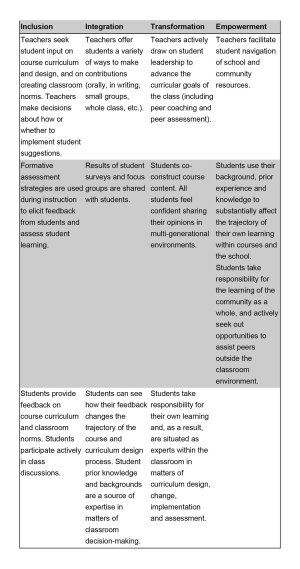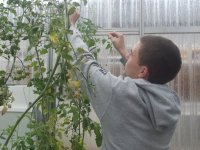Including Student Voice
Science teacher and curriculum coach Bill Palmer continues Sammamish High School’s blog series about the seven key elements for integrating PBL with an examination of Student Voice.
In last week's post, my colleague Adrienne Curtis Dickinson introduced seven key elements of problem-based learning at Sammamish High School. These key elements guide both the professional learning experiences for Sammamish staff and the ongoing PBL curriculum design. This week is our chance to share the variety of ways that the key element of student voice has been incorporated into teaching and learning.
What is Student Voice?
The term "Student Voice" describes how students give their input to what happens within the school and classroom. Our desire is for students to know that their expertise, opinions and ideas are valued in all aspects of school life. Student Voice permeates all levels of our work together, from students participating in small group classroom conversations to students partnering in curriculum design or establishing school norms and policy.
Why is Student Voice Important?
One of the principles guiding the transformation work at Sammamish is that student achievement and engagement will increase when students have more ownership of their school community. The Student Voice key element reinforces that:
- What students have to say matters in how learning happens.
- Students have untapped expertise and knowledge that can bring renewed relevance and authenticity to classrooms and school reform efforts.
- Students benefit from opportunities to practice the problem solving, leadership and creative thinking required to participate in a decision-making school community.
What Does Student Voice Look Like?
As students traverse different courses and grade levels throughout high school, they should experience all aspects of the Student Voice implementation continuum represented in the following table. Our expectation is that teachers and students will move back and forth between the different levels of implementation according to curriculum, classroom or school community needs.

The key element of Student Voice signals important shifts in both teacher and student roles. Through creating space for students to be more active participants in the learning process, we are seeing innovative teaching practices emerge. Following are a few snapshots of what I've experienced as a teacher during the last few years of working with the student voice key element.
Student Voice in Action
Shifting to problem-based learning dramatically increases student voice in learning. During a STEM experience designing aquaponics systems (raising produce and fish together), students had opportunities to learn about typical content standards like human nutrition, cellular processes in plants, and matter and energy cycling. What differs when teaching through PBL is the amount of choice students have in how they direct and demonstrate their learning. When teachers brought in outside clients to request and evaluate student aquaponics designs, it sent a clear message that student thinking, creativity, communication and learning were valued by the extended school community.
During the last school year, one of our grant partners from the University of Washington was experimenting with student focus groups in science classes implementing PBL units. A group of 8-10 students might gather for lunch with a lot of pizza, a voice recorder, and some questions to start a conversation. What made this experience unique was our opportunity as teachers to read the anonymized transcript of the student conversation and process together the implications for teaching and learning. This year we hope to extend the process by asking and listening as students describe the changes they experience as a result of giving their input. As teachers and students become more comfortable sharing opinions and ideas, involving students in the instructional change process should become a routine part of our practice.
The Investing in Innovation (i3) grant affords teachers, administrators, and our grant partners five days during the summer to gather and learn from each other about the key elements of PBL. For many teachers, the highlight of the week involves the opportunity to hear from and learn about our students. Past graduates returned to talk about what components of their Sammamish experience have made a difference as they transition to college. Current students have shared how their family background, language or prior schooling experiences influence their experience as a Sammamish student. There is a refreshing parity created when students are treated as the experts who share valuable perspectives and ideas with a learning-focused group of teachers. One of our students put it this way:
The teachers and the administration as well as other leaders in the school always want student input to move forward in their plans. As a student, I truly appreciate that because it makes me feel welcome and part of the SHS community. It motivates me to really want to learn because I feel part of the learning environment; I don't have to try to fit in, every student just falls into place.
What Next?
The Sammamish community is continuing to learn and experiment within the key element of Student Voice. We would welcome any additional resources or reflections you might have. Please share your suggestions in the comments section below.
Editor's Note: Visit "Case Study: Reinventing a Public High School with Problem-Based Learning" to stay updated on Edutopia's coverage of Sammamish High School.
